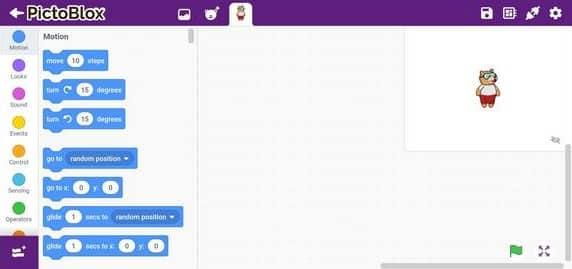- Session 1 and Session 2: Introduction to various Coding Platforms
-
Session 3: Creating Animation
-
Session 3: Creating Animation
- Session 4: Story Making
-
Session 5: Let's Play- Game Development
-
Session 6: Getting Familiar with Microbit
-
Session 7: Emotional Robot Microbit
-
Session 8: Beating Heart
-
Session 9: Name Badge
-
Session 10
-
Session 11
-
Session 12 and Session 13
-
Session 14
-
Session 15
-
Session 16
-
Session 17
-
Session 19
-
Session 21
-
Session 22
-
Session 23
-
Session 24
Introduction to various coding platforms
INTRODUCTION TO VARIOUS
CODING PLATFORMS
"Everybody in this country should learn to program a computer… because it teaches you how to think."  — Steve Jobs
— Steve Jobs
In today’s digital world, learning to code has become an essential skill. Coding platforms provide a structured environment where learners can write, run, and test their programs. These platforms range from beginner-friendly interfaces to professional development environments. In this session, we will have an overview of some popular coding platforms.
Introduction
In this session, we will take our first steps into programming using fun and interactive platforms like Scratch, Edublocks, MakeCode, and PictoBlox. These tools are designed to make coding easy and enjoyable, especially for beginners.
Through colourful blocks and simple drag-and-drop features, you'll learn how to build instructions for computers to follow. Whether it’s making a character dance, creating a game, or telling a digital story, you’ll discover how your ideas can come to life with just a few blocks of code.
This session is all about learning by doing. So, get ready to explore, create, and enjoy the magic of coding!
Prerequisite Knowledge
- Basic computer operation skills (using mouse, keyboard, and navigating a browser).
- Understanding of how to open and use simple software or web applications.
- Familiarity with the concept of instructions or steps (e.g., following directions in daily life).
- Ability to read and follow simple English instructions.
- No prior programming knowledge is required, but curiosity and willingness to explore are encouraged!
Learning Objective
- Understand the basics of block-based programming.
- Explore beginner-friendly coding platforms: Scratch, Edublocks, MakeCode, and PictoBlox.
- Learn how to sequence instructions to perform specific tasks.
Requirements
- A computer or laptop.
- A stable internet connection.
- Pre-installed necessary softwares and applications.
🌟 Scratch
Scratch uses block-based coding — instead of typing code, you snap colorful blocks together like a puzzle to create programs. It’s ideal for making animations, games, stories, and even music.

💡 Key Features of Scratch
| Feature | Description |
|---|---|
| Block-Based Programming | No syntax errors — just drag and drop code blocks |
| Creative Projects | Make games, animations, and interactive stories |
| Sprites and Backdrops | Choose or draw your own characters and scenes |
| Online Community | Share your projects and explore others’ work |
| Works on Browser | No need to install — runs on scratch.mit.edu |
🧠 Why Use Scratch?
- Easy to learn for kids aged 7+
- Helps build logical thinking and problem-solving
- Encourages creativity and storytelling
- Great for school projects, coding clubs, and ATL labs
🛠️ What Can You Make with Scratch?
- Animated stories
- Maze games and quiz apps
- Music and sound projects
- Interactive greeting cards
- Simulations of real-world events (e.g., weather, traffic)
🧑🏫 Scratch in Education
- Aligned with 21st-century skills
- Used in CBSE coding curriculum
- Encourages peer learning and sharing
- Supports multidisciplinary learning (Math + Art + Tech)
🌟 PictoBlox
PictoBlox is a graphical programming platform based on Scratch. It allows users to program using block-based coding and also supports Python for advanced learners. It is widely used in STEM and robotics education.

💡 Key Features of PictoBlox
| Feature | Description |
|---|---|
| Block-based Interface | Drag-and-drop coding blocks make it easy for beginners |
| Python Mode | Switch to Python for real-world coding experience |
| AI & Machine Learning Tools | Face recognition, speech detection, pose estimation, etc. |
| Robotics Integration | Works with hardware like evive, Arduino, and ESP32 |
👨🎓 Best For:
- School students (classes 3 to 12)
- Beginners in coding and robotics
- STEM and AI learning projects
- Building real-time hardware + software applications
📦 What You Can Make with PictoBlox:
- Line-following and obstacle-avoiding robots
- Face recognition door lock systems
- Talking AI bots
- Weather monitoring systems
- Educational games and animations
🌟 MakeCode
MakeCode is an online coding editor that allows users to create programs for micro: bit using:
- Block-based coding (ideal for beginners)
- JavaScript or Python (for advanced users)

💡Key Features of MakeCode for Microbit
| Feature | Description |
|---|---|
| Drag-and-drop Blocks | Easy for beginners to code with visual blocks |
| Real-time Simulator | Test your code before uploading to micro: bit |
| Switch to JavaScript/Python | Seamless transition from blocks to text-based code |
🎯 What Can You Make with MakeCode + Microbit?
- Step counters using an accelerometer
- Digital dice or compass
- Temperature and light monitors
- Games using LEDs and buttons
- Smart home projects (e.g., alarms, light sensors)
- Remote-controlled robots
🧑🎓 Why Learn with MakeCode?
- Beginner-friendly interface
- Encourages problem-solving and logical thinking
- Supports both simulation and real hardware interaction
- Ideal for STEM education, ATL labs, and robotics clubs
🌟 EduBlocks
EduBlocks allows users to write real Python code using block-based interfaces. Each block represents actual Python syntax, which helps learners see and understand real code while still using a visual environment.
💡 Key Features of EduBlocks
| Feature | Description |
|---|---|
| Block-Python Bridge | Blocks are matched with actual Python code syntax |
| Multiple Languages | Supports Python, MicroPython, HTML, and JavaScript |
| Device Compatibility | Works with micro:bit, Raspberry Pi, CircuitPython, etc. |
🛠️ What Can You Make with EduBlocks?
- Simple Python programs and games
- LED and sensor projects using micro:bit or Raspberry Pi
- Web pages using HTML/CSS
- IoT projects with real hardware
- Python-based data and AI projects
🌟 ArduBlocks
ArduBlocks is an add-on for the Arduino IDE that lets users program Arduino boards using drag-and-drop blocks. It converts visual blocks into actual Arduino code (C/C++) behind the scenes.
🌟 Key Features of ArduBlocks
| Feature | Description |
|---|---|
| Block-Based Programming | Easy visual interface for beginners |
| Real Arduino Code Generation | Behind-the-scenes C/C++ code helps transition to text coding |
| Hardware Interaction | Works with LEDs, motors, sensors, buzzers, etc. |
🛠️ What You Can Do with ArduBlocks
- Turn LEDs on/off
- Read values from sensors (like temperature, light, IR)
- Control motors and servos
- Build basic robotics projects
- Make obstacle-avoiding or line-following robots
- Display data on LCD screens
🧠 Why Choose ArduBlocks in Education?
- Beginner-friendly: No need to memorize syntax
- Visual learning: Ideal for introducing physical computing
- Logical thinking: Helps understand how hardware responds to code
- Transitional tool: Prepares learners for Arduino C++ programming
📦 Requirements to Use ArduBlocks
- Arduino board (Uno, Nano, etc.)
- Arduino IDE installed on PC
- ArduBlock extension added to Arduino IDE
- USB cable for programming the board
🛠️ ACTIVITY
Create a simple Animation using the Scratch 3.0 platform.
Follow the steps below:
Step 3: Now, to start the program, go to event palette, Add a green flag block.
🎯 Outcomes
By the end of this chapter, students will be able to:
- Understand and apply fundamental coding concepts such as sequencing, loops, and events using visual block-based platforms like Scratch, EduBlocks, MakeCode, and PictoBlox.
- Design and develop simple interactive projects, including stories, animations, and games, by arranging code blocks in a logical sequence.
- Gain confidence in exploring various coding tools and platforms.
- Demonstrate creativity in project design and implementation.
- Enhance their problem-solving abilities and logical thinking skills through hands-on coding activities.
Output
There are no comments for now.